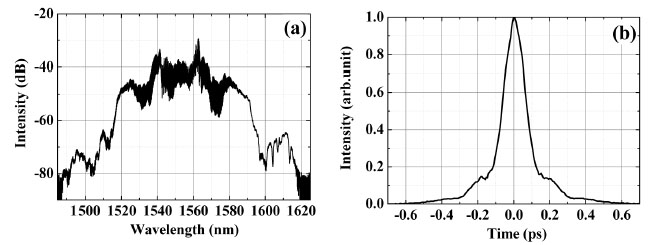Optical Science Laboratory
Femtosecond pulse lasers with a gigahertz repetition rate are attractive
for a variety of applications, including the analysis of nanomechanical
and optomechanical systems, as a multiphoton tool for nanomedicine and
nanobiotechnology, for high-speed asynchronous optical sampling, and as
a carrier-envelope-offset-locked frequency comb with a wide mode spacing
[1]. Conventional methods for generating a femtosecond pulse train are
based on a passive mode-locking technique. However, since the cavity length
must correspond to the repetition rate, it is difficult to obtain femtosecond
pulses with a high repetition rate exceeding 1GHz. Moreover, the repetition
rate and wavelength have limited tunability. We propose a simple method
to generate GHz repetition rate optical pulses with a widely selectable
repetition rate and wavelength by using commercial optical phase-modulators
(PMs), a commercial intensity-modulator (IM), and a standard single-mode
fiber (SMF).
The phase of the light from a CW laser diode (LD) with a center wavelength
of 1552 nm are modulated with PMs driven by an external RF synthesizer
at modulation frequency of 25 GHz. This process causes repetitive up- and
down-chirping at 25 GHz. The linear part of the down-chirping is selectively
gated with the IM, resulting in a flat optical frequency comb with a 24-nm
bandwidth. After chirping compensation with a SMF, we obtained a 230-fs
pulse at 25 GHz. After an optical gate, which reduces the repetition rate
from 25 GHz to 1 GHz (or 250 MHz), the optical pulse train is amplified
up to an average power of 1 W in an erbiumdoped fiber amplifier (EDFA).
Since the laser peak intensity is estimated to be more than several kilowatts
in the EDFA, spectral broadening occurs by self-phase modulation. Then,
the chirped pulse is compressed by 1-m-long glass block. We succeeded in
the generation of a 1-W, 120-fs optical pulse at 1 GHz and a 1-W, 80-fs
optical pulse at 250 MHz [2]. Figure 1 shows the spectrum and autocorrelation
trace for the latter case. As far as we know, these are the shortest pulses
ever achieved for these repetition rates using a CW LD as a seed light
source. Our scheme could provide a sub-100-fs laser with widely tunable
repetition rate and wavelength by changing the modulation frequency of
the RF synthesizer and the wavelength of a tunable laser diode. These features
mean that our proposed laser system has the potential to become a powerful
tool for a variety of applications.
[1] A. Ishizawa, T. Nishikawa et al., Electron. Lett. 46 (2010) 1343.
[2] A. Ishizawa, T. Nishikawa et al., Optics Express 23 (2011) 22402.
 |
||
|